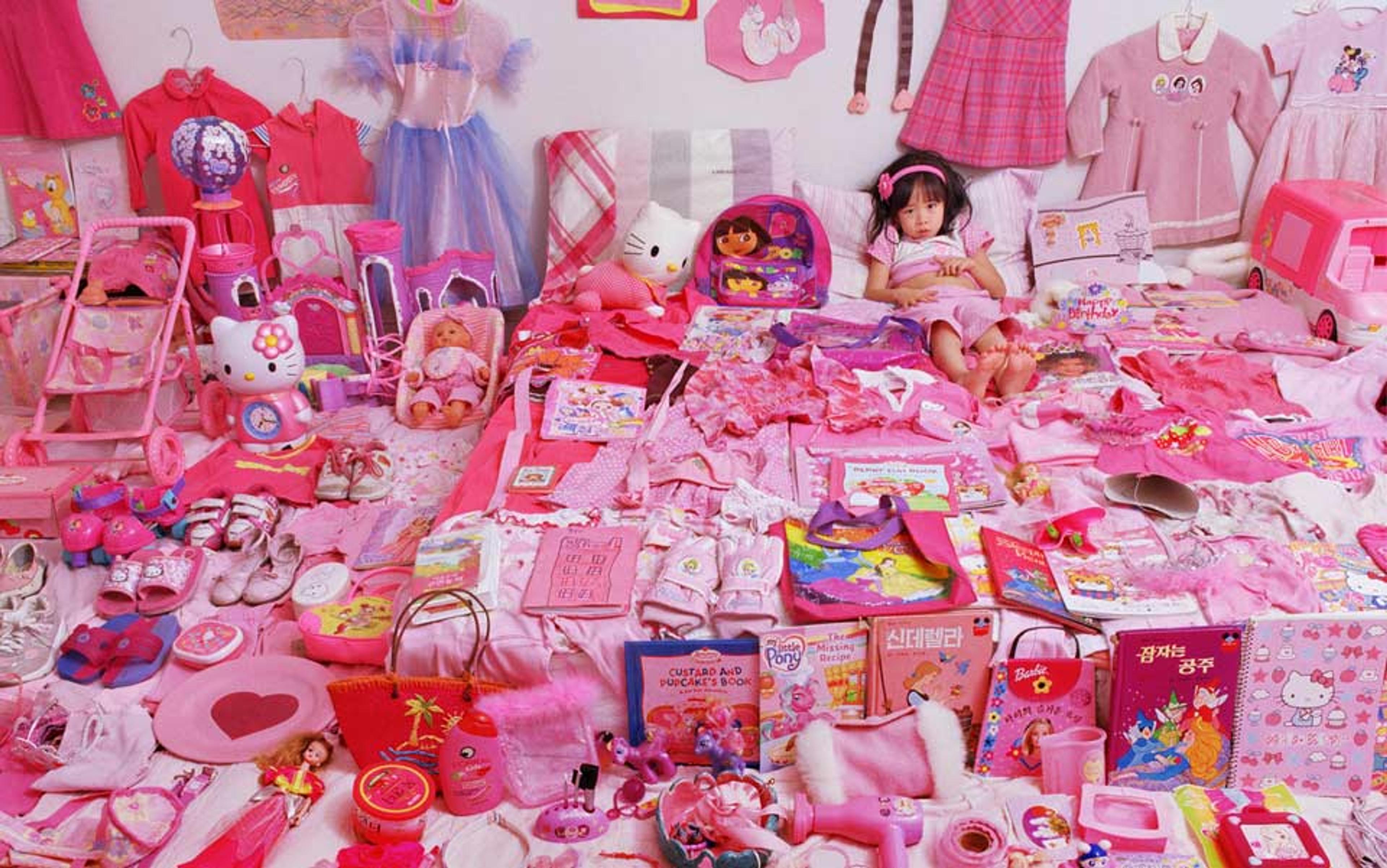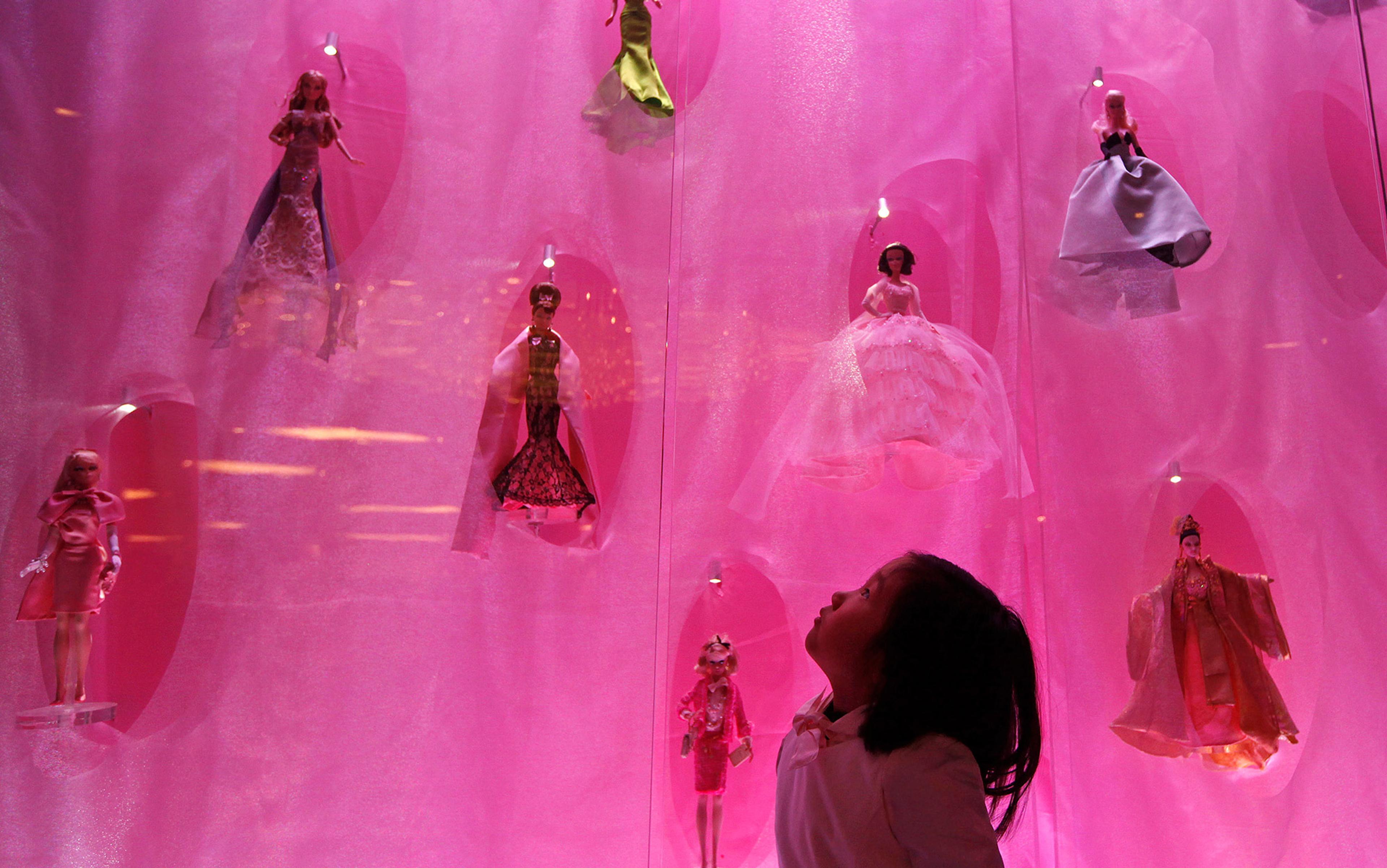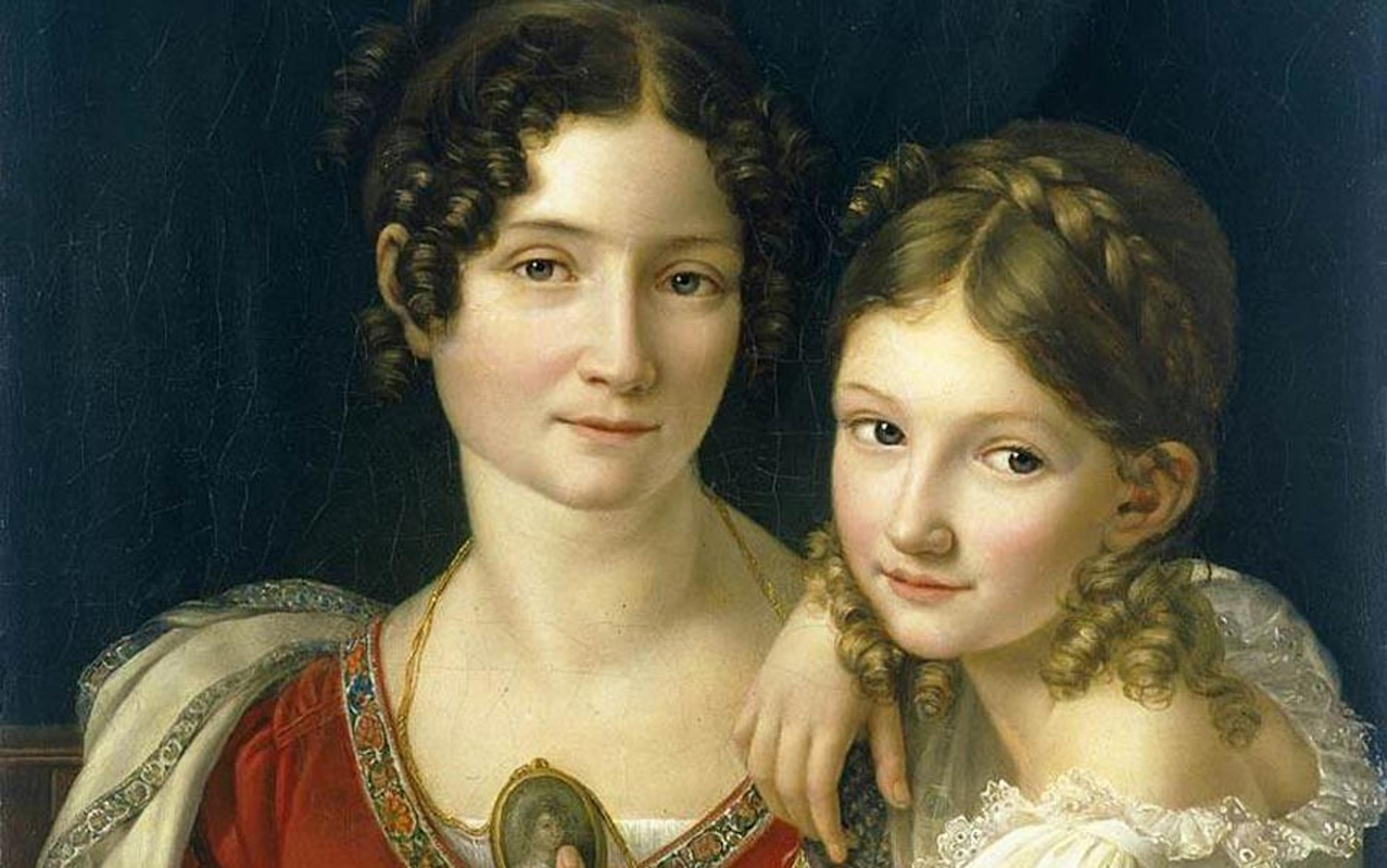Lately, I’ve been thinking about pink a lot. I have a daughter who recently turned two and is quite vocal in her opinions, especially concerning the glory of pink and the intrinsic goodness of things that happen to be pink: for instance, that strawberry ice-cream is maximally delicious, in virtue of its colour. My daughter’s passion for pink is, most obviously, a form of comeuppance visited upon me by an irony-loving universe, since I’ve always steered away from it myself. I often wonder, how can she be so inexorably drawn to pink, even before having any peers to mimic? And why am I so irked by pink? Why should I even care what she wears?
The daily ritual of dressing has become a pink-suffused, intensive negotiation. Most of her clothes are hand-me-downs, and pink is heavily represented. But the various donation streams present different pinks reflecting their different socioeconomic origins, ranging from the all-American hot pink of a cardigan from a mass-market label such as Carter’s to the dusty rose of a dress from a more select collection such as Tea’s.
My daughter seems not to differentiate among these pinks, generally adopting a policy of ‘more, more, more’; but I find myself repelled by some and attracted to others. While some pinks strike me as tacky, flat and one-dimensional, others look delicate, or resonant. Some go nicely with blue or grey leggings, while others demand white, or maybe stripes. Some make her look cute and spunky; others washed-out and dumpy.
These are thoroughly aesthetic judgments, though I have a hard time telling where they come from, or what could justify them. I’ve tried telling myself that none of it matters. Pink is fine, I mutter. She’ll just cover it in paint and apple sauce anyway. But they continue to nag, tugging at the corners of my mind.
It turns out that the ‘pure’ phenomenal property is anything but: pink – or rather, various pinks – are imbued with thick, sticky, if largely intuitive, cultural significance. They are allied to, and in tension with, other colours in ways that make them suitable components of some overall styles and not others: hot pink fits with zebra stripes and metallic-silver stars; ballerina pink with tulle and hearts; dusty rose with gingham or Art Nouveau flowers. And those styles, in turn, fit with different personalities: sassy, sweet, elegant.
Pink matters, then, because it is bound up with ways of being in the world that are partially aesthetic, but also personal and political. Colours encode aesthetic norms that run straight through to style, personality, culture, and class.
My daughter cares about pink because she’s attuned to these norms. Even in the absence of obviously gendered toys, without anyone urging her to be ‘a good girl’, with her only peers encountered fleetingly on the playground, and with limited (though burgeoning) verbal skills, she’s figured out that pink is for girls, which is something she wants to be. Her first forays in the world of aesthetics are also explorations in self-identity. This is also why I care about pink: my aesthetic judgments about colour, direct and immediate as they are, are now charged with my hopes and fears for her and her place in the world. I want her to be beautiful and kind and smart; I hope she grows up to be strong and self-determining; I fear she will be drowned in a sea of girlitude, as in JeongMee Yoon’s portrait of her daughter, SeoWoo and Her Pink Things (2006).
It wasn’t always this way. Maybe pink was always freighted, but it wasn’t always for girls. According to Jo B Paoletti, professor of American studies at the University of Maryland, white clothing was common for children of both sexes well into the 19th century, because colour dyes couldn’t sustain the rigours of repeated washing.
When colours did become more common, the gender affiliation went in the other direction, in virtue of aesthetic colour judgments that would have seemed just as obvious but differed starkly from our own. Thus, a 1918 article in the trade publication Earnshaw’s Infants’ Department intoned that: ‘The generally accepted rule is pink for the boys, and blue for the girls. The reason is that pink, being a more decided and stronger colour, is more suitable for the boy, while blue, which is more delicate and dainty, is prettier for the girl.’ The contemporary gender association emerged in the 1940s but retreated somewhat in the 1970s – when feminism helped popularise a more unisex style – until the mid-1980s, when marketers began promoting strongly gender-differentiated clothes, diapers, cribs and toys.
Our contemporary palette of pinks is also of fairly recent vintage. The instability of dyes made pale pink the only viable option until chemical advances enabled the Italian fashion designer Elsa Schiaparelli to launch the perfume ‘Shocking’ in 1937, named for her signature colour, ‘shocking pink’, which featured in her avant-garde designs, often in collaboration with other artists such as Jean Cocteau, Salvador Dalí and Man Ray.
Every time I choose a dusty-rose dress over a bubblegum shirt, I propagate invidious class distinctions I would prefer to resist
However, just because our responses to colour are constructed, it doesn’t mean that they, or what they’re responding to, aren’t real. My aesthetic responses to pink – like my daughter’s – are direct and immediate, something I can’t easily alter or put aside. My taste for some pinks over others, and for other combinations of colours, textures and patterns, is part and parcel of a more encompassing set of tastes extending to food, furniture, turns of phrase, music, and ‘high’ art. These visceral, unreflective judgments hang together in a complex habitus, as the French scholar Pierre Bourdieu would say: a larger nexus of values, dispositions, and ways of acting, which is itself the product of my own meandering navigation through the socioeconomic environment. Every time I dress myself – or my daughter – I signal who I am; where and how I fit in. Other people pick up on and respond to these signals, and conforming to and flouting the resulting expectations has consequences that can be just as potent as catching a virus or walking into a brick wall.
Like it or not, then, we’re consigned to deal with the baggage of pink. Still, there’s clearly a lot not to like. On the one hand, my gut reaction against my daughters wearing hot pink and zebra stripes is an unvarnished expression of snobbery. This is natural, and to some extent unavoidable: one of my parental tasks is to transmit the ‘cultural capital’ I’ve accrued, so that my children can locate themselves appropriately in the world – so that the most doors can be open to them, by knowing what signals they’re sending.
Further, part of my aversion to hot pink derives from my (I believe justified) aversion to its associated schema: to a girlhood of cupcakes and poodles, where manicures and shopping are the intrinsically entertaining, self-actualising activities. By contrast, it’s easier for me to embrace the connotations surrounding dusty rose: gardens, tea and crumpets, woodland fairies. But obviously, not everyone has the option to buy, or inherit, their clothes from Tea instead of Target. Every morning that I choose the dusty-rose dress over the bubblegum shirt, I propagate invidious class distinctions that I would prefer to resist.
On the other hand, both hot pink and dusty rose are bound up with gender codes that are at least stifling and plausibly repressive. Many of the boys at my son’s preschool liked pink, at least up to the age of four. Maybe it struck them as a ‘decided and strong colour’, or maybe they just liked it. (When he was a child, my husband deemed it his favourite, perhaps largely out of sheer cussedness.) However, by the time these boys reached kindergarten, these proclivities had been largely extinguished or at least repressed, except in those few who have doubled down with nail polish and ruffles. Just before our daughter’s birth, our son announced that he was ‘allergic’ to pink. Now, he exhorts his friends: ‘We don’t like princesses and pink, do we?’ Which, on the one hand: right. But on the other: no!
The exclusion of boys from a wide range of perfectly viable, even important forms of dress and play because of their association with femininity is bad enough. But in a patriarchial society, the confinement of girls to a limited set of permissible ways of being is considerably worse. In particular, there is empirical evidence, such as the 1998 research from the University of Michigan, Ann Arbor, to suggest that highly gendered clothing can serve as a trigger for ‘stereotype threat’, meaning that girls and women end up performing worse than they could on tests of stereotypically male abilities, such as mathematics and engineering.
These seem like decent reasons for my daughter not to go around constantly swathed in pink: it encodes pernicious ‘heteronormative’ – or straight gender-specific – values. At the same time, she just does really like it. And it’s not as if she’s engaged in some form of false consciousness, grabbing on to something she doesn’t genuinely enjoy because other people tell her she should. She’s too hard at work constructing who she is in the first instance. And a crucial, unavoidable form of self-construction is feeling one’s way in to a style, finding what’s fitting for your own particular personality. She likes pink because it helps her to actualise her self. For me to banish pink from her wardrobe would be, if anything, like trying to enforce some alien law upon her – or, as philosophers might say, something ‘heteronomous’.
So what are we, her parents, as right-thinking, over-educated, squarely upper-middle-class people, to do? One option is to actively appropriate pink by reassessing its associated values, much as targeted groups have done with slurs such as ‘queer’. My husband and I do attempt this with the princess mania that besets pre‑kindergarten girls, giving them Xena the warrior princess figurines for birthdays instead of the flouncy Disney royalty they would clearly prefer (not that Xena is entirely unproblematic in her own right). But reappropriation can’t be achieved in isolation; in the absence of a co-ordinated counter-cultural movement, it just perpetuates established stereotypes.
Besides, ‘pink pride’ is easily co-opted, so that uplifting revolutionary action becomes just another case of capitalist accomodation. I’ve decided this is why I hate the Disney film Frozen (2013). I’d prefer my daughter to play with regular construction tools and Lego, not their cutesy, heart-embossed, pink versions. And the Pink Nation range from Victoria’s Secret seems like a thinly disguised attempt to sexualise tweenhood by marketing thongs alongside sweatpants and bedding.
Mostly, I think, people like us just grit our teeth, indulge a wide multiplicity of pinks, wait for first grade – and (in my family’s particular case) the advent of the school uniform. We can play some of what Glamour magazine called P!nk’s ‘big-voiced, tough-chick music’. We can extol the beauties of blue and yellow. I can be less of a snob, accepting hand-me-downs of every colour with much-merited gratitude. I can watch my daughter become herself, embracing and rejecting the various expectations that surround her – including her parents’. I’m confident she will have navigated what I like to call the ‘Five Stages of Gender Acceptance’ by the end of high school (ok, maybe more like college), moving from the shockingly short-lived phase of blissful ignorance to her current rather full-throated embrace, and on to more nuanced forms of negotiation. Hopefully, she’ll be comfortable wearing the pinks that I’ve often eschewed as too girly, weaving them as one strand within a multi-hued wardrobe. Ideally, she’ll convince her brother to spring for some snazzy pink hi-top trainers all of his own.






